
Boron is a chemical element with symbol B and atomic number 5. Produced entirely by cosmic ray spallation and supernovae and not by stellar nucleosynthesis, it is a low-abundance element in the Solar system and in the Earth's crust. Boron is concentrated on Earth by the water-solubility of its more common naturally occurring compounds, the borate minerals. These are mined industrially as evaporites, such as borax and kernite. The largest known boron deposits are in Turkey, the largest producer of boron minerals.

In chemistry, a carbide is a compound composed of carbon and a less electronegative element. Carbides can be generally classified by the chemical bonds type as follows: (i) salt-like, (ii) covalent compounds, (iii) interstitial compounds, and (iv) "intermediate" transition metal carbides. Examples include calcium carbide (CaC2), silicon carbide (SiC), tungsten carbide (WC; often called, simply, carbide when referring to machine tooling), and cementite (Fe3C), each used in key industrial applications. The naming of ionic carbides is not systematic.

Group 4 is a group of elements in the periodic table.
It contains the elements titanium (Ti), zirconium (Zr), hafnium (Hf) and rutherfordium (Rf). This group lies in the d-block of the periodic table. The group itself has not acquired a trivial name; it belongs to the broader grouping of the transition metals.

Control rods are used in nuclear reactors to control the fission rate of uranium and plutonium. They are composed of chemical elements such as boron, silver, indium and cadmium that are capable of absorbing many neutrons without themselves fissioning. Because these elements have different capture cross sections for neutrons of varying energies, the composition of the control rods must be designed for the reactor's neutron spectrum. Boiling water reactors (BWR), pressurized water reactors (PWR) and heavy water reactors (HWR) operate with thermal neutrons, while breeder reactors operate with fast neutrons.

Titanium diboride (TiB2) is an extremely hard ceramic which has excellent heat conductivity, oxidation stability and resistance to mechanical erosion. TiB2 is also a reasonable electrical conductor, so it can be used as a cathode material in aluminium smelting and can be shaped by electrical discharge machining.

A superhard material is a material with a hardness value exceeding 40 gigapascals (GPa) when measured by the Vickers hardness test. They are highly incompressible solids with high electron density and high bond covalency. As a result of their unique properties, these materials are of great interest in many industrial areas including, but not limited to, abrasives, polishing and cutting tools and wear-resistant and protective coatings.
A trauma plate, also known as a trauma pack or trauma pad, is a plate that is an add-on component/insert to a ballistic vest. Its primary purpose is to absorb and disrupt the kinetic energy of a bullet impact and reduce the blunt trauma transferred to the wearer of the vest. Trauma plates typically enhance the ballistic value of the part of the vest that they are positioned behind.
Boron trichloride is the inorganic compound with the formula BCl3. This colorless gas is a reagent in organic synthesis. It is highly reactive toward water.

Rhenium diboride (ReB2) is a synthetic superhard material. It was first synthesized in 1962 and re-emerged recently due to hopes of achieving high hardness comparable to that of diamond. The reported ultrahigh hardness has been questioned, although this is a matter of definition as in the initial test rhenium diboride was able to scratch diamond.
Aluminium dodecaboride (AlB12) is a chemical compound made from the metal aluminium and the non-metal boron. It is one of two chemical compounds that are commonly called aluminium boride; the other is aluminium diboride, AlB2.
A pyrotechnic initiator is a device containing a pyrotechnic composition used primarily to ignite other, more difficult-to-ignite materials, e.g. thermites, gas generators, and solid-fuel rockets. The name is often used also for the compositions themselves.

Zirconium diboride (ZrB2) is a highly covalent refractory ceramic material with a hexagonal crystal structure. ZrB2 is an ultra high temperature ceramic (UHTC) with a melting point of 3246 °C. This along with its relatively low density of ~6.09 g/cm3 (measured density may be higher due to hafnium impurities) and good high temperature strength makes it a candidate for high temperature aerospace applications such as hypersonic flight or rocket propulsion systems. It is an unusual ceramic, having relatively high thermal and electrical conductivities, properties it shares with isostructural titanium diboride and hafnium diboride.
Aluminum magnesium boride or BAM is a chemical compound of aluminium, magnesium and boron. Whereas its nominal formula is AlMgB14, the chemical composition is closer to Al0.75Mg0.75B14. It is a ceramic alloy that is highly resistive to wear and has an extremely low coefficient of sliding friction, reaching a record value of 0.02 in lubricated AlMgB14−TiB2 composites. First reported in 1970, BAM has an orthorhombic structure with four icosahedral B12 units per unit cell. This ultrahard material has a coefficient of thermal expansion comparable to that of other widely used materials such as steel and concrete.

Ruthenium borides are compounds of ruthenium and boron. Their most remarkable property is potentially high hardness. Vickers hardness HV = 50 GPa was reported for thin films composed of RuB2 and Ru2B3 phases. This value is significantly higher than those of bulk RuB2 or Ru2B3, but it has to be confirmed independently, as measurements on superhard materials are intrinsically difficult. For example, note that the initial report on extreme hardness of related material rhenium diboride was probably too optimistic.

Frederick Nye Tebbe was a chemist known for his work on organometallic chemistry. Tebbe was born in Oakland, California on March 20, 1935. His father, Charles L. Tebbe, worked for the United States Forest Service so Fred’s early education took place in Montana, Oregon, Maryland and Pennsylvania. He married Margaret Manzer in 1960, and they had a son and a daughter. He died of pancreatic cancer at his home in Delaware on September 28, 1995.
Ultra-high-temperature ceramics (UHTCs) are a class of refractory ceramics that offer excellent stability at temperatures exceeding 2000 °C being investigated as possible thermal protection system (TPS) materials, coatings for materials subjected to high temperatures, and bulk materials for heating elements. Broadly speaking, UHTCs are borides, carbides, nitrides, and oxides of early transition metals. Current efforts have focused on heavy, early transition metal borides such as hafnium diboride (HfB2) and zirconium diboride (ZrB2); additional UHTCs under investigation for TPS applications include hafnium nitride (HfN), zirconium nitride (ZrN), titanium carbide (TiC), titanium nitride (TiN), thorium dioxide (ThO2), tantalum carbide (TaC) and their associated composites.

Niobium diboride (NbB2) is a highly covalent refractory ceramic material with a hexagonal crystal structure. NbB2 is an ultra high temperature ceramic (UHTC) with a melting point of 3050 °C. This along with its relatively low density of ~6.97 g/cm3 and good high temperature strength makes it a candidate for high temperature aerospace applications such as hypersonic flight or rocket propulsion systems. It is an unusual ceramic, having relatively high thermal and electrical conductivities (Electrical resistivity of 25.7 µΩ⋅cm, CTE of 7.7⋅10−6 °C−1), properties it shares with isostructural titanium diboride, zirconium diboride, hafnium diboride and tantalum diboride.









